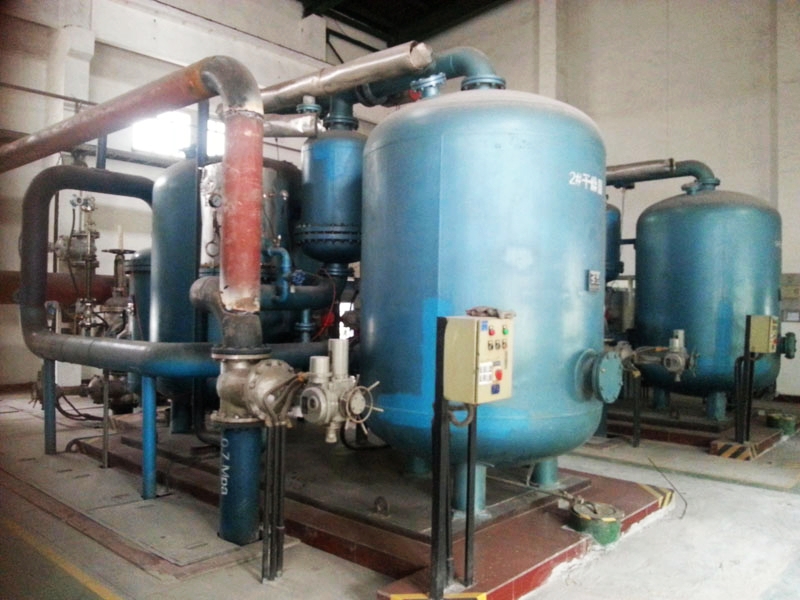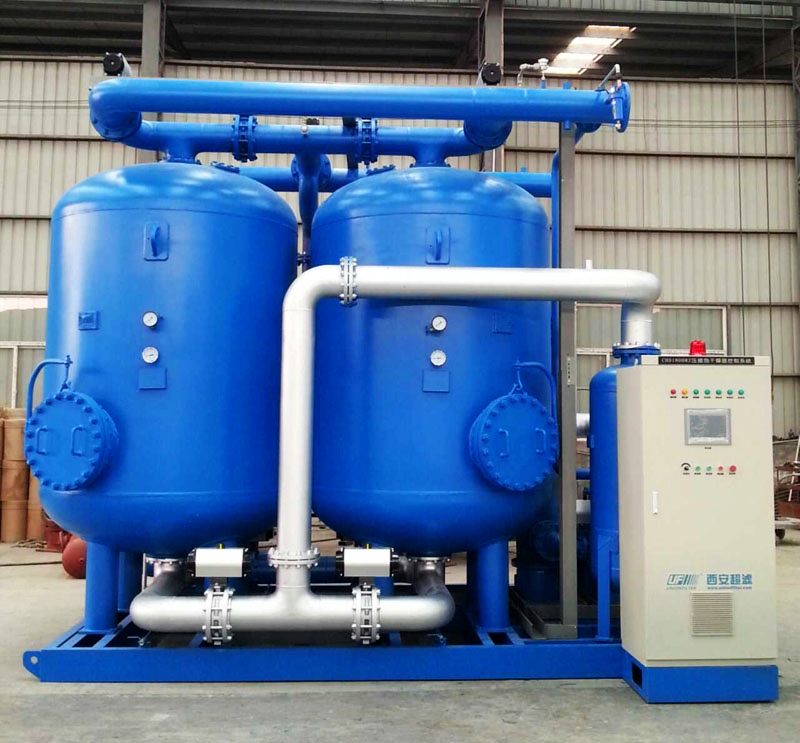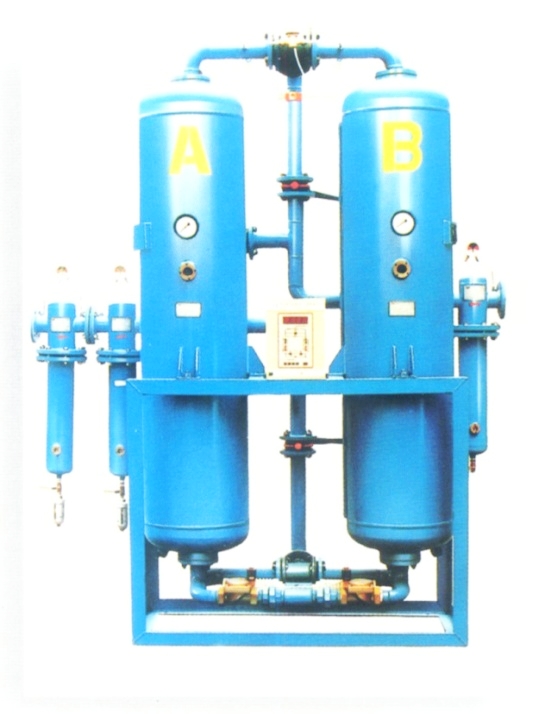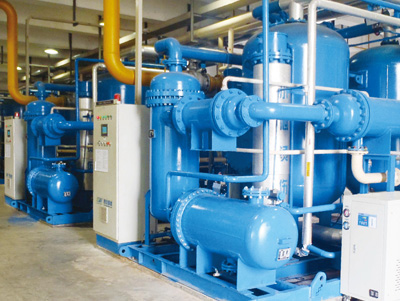新闻动态
The new generation of air compressor system energy-saving technology has achieved remarkable results
责任编辑:作者:admin人气:86 发表时间:2025-07-22
-- Xi'an Ultrafiltration's Fourth Generation Adsorption-Type Dryer Helps Tangsteel Achieve Energy Conservation and Emission Reduction
By Li Daming
In recent years, the steel industry has been in a downturn. Internal optimization is imperative. Hebei Steel, which is responsible for reducing emissions and alleviating smog in the surrounding areas of Beijing, is facing significant pressure to meet the targets. The leader of Hebei Steel, Tangsteel, has focused on the high-energy-consuming air compressor system. The first phase of the energy-saving renovation project was allocated to the cold-rolled sheet and 3200 blast furnace air compressor stations. The main contents of the renovation were: first, to separate high (7 bar) and low (4.5 bar) pressure flows; new 2-stage compression low-pressure centrifugal air compressors and dedicated low-pressure pipelines were purchased; second, the first-generation micro-heated adsorption-type dryer with high energy consumption was replaced.


According to the actual on-site measurement by Tanggang Steel, the original micro-heating regenerative dryer consumed 8% to 20% of the regeneration gas volume. A low regeneration gas volume resulted in an unqualified dew point, which was only equivalent to the level of a cold dryer (-17℃). However, a regeneration gas volume that could meet the dew point requirement was as high as 15%. Even worse, the regeneration gas volume reached 20%, but still failed to meet the -40℃ requirement for atmospheric pressure dew point. After preliminary calculation: The output gas volume of the two air compressors Q = 2000 Nm3/min, the average regeneration gas consumption is 12%. According to the internal accounting price, the cost of oil-free dry compressed air per cubic meter is 0.12 yuan. With an operation time of 8000 hours, the annual operating cost of the emitted gas is: 0.12 yuan × (2000 × 12% × 60 × 8000) = 13.82 million yuan/year.
In addition, according to the internal factory calculation price, each kilowatt-hour costs 0.5 yuan. The unit power required by the micro-heating electric heater is 36KW (based on 100 Nm3/min per minute), the regeneration cycle is 4 hours, with 2 hours of heating, and it is switched 6 times a day. Then the annual electricity cost is:
0.5 yuan × (2000/100 × 36 × 2h × 6 times × 8000/24) = 1.44 million yuan/year. The total cost of the two items is: 15.26 million yuan/year.
The energy-saving technical renovation of Tangsteel's air compression system adopts the "Energy Management Contract" model. The two parties, Party A and Party B, will share the benefits based on the energy-saving effect. Party B won the bid for the equipment tender with the highest price and selected the fourth-generation low dew point, low drift, zero gas consumption compression heat regeneration dryer from Xi'an Ultrafiltration, totaling 8 sets of equipment. The winning bid price was over 5 million yuan, which was 10 to 30% higher than that of other competitors. Clearly, Party B was not concerned about the equipment price, but rather the difference in operating costs between the original micro-heating equipment (15 million yuan per year) and the new equipment provided by Party C. The operating cost of the zero gas consumption machine provided by Xi'an Ultrafiltration is only the electricity cost for auxiliary electric heating and circulating fans, which has a very small power and can be ignored. The electric heater is only activated at the final stage of heating, generally for 0.5 hours, and the required power and calculation method are similar to that of the micro-heating. Therefore, the electricity cost is: 0.5 yuan × (2000/100 × 36 × 0.5 × 6 × 8000/24) = 360,000 yuan per year. The ratio of 36/1526 is 2.36%, even if it is doubled, it does not exceed 5%. Truly, it is astonishing when you realize it.
At present, the 8 sets of equipment installed and put into operation in the first phase of Tangsteel have achieved unexpected energy-saving effects. Personnel from other divisions of Tangsteel and relevant personnel from Hebei Steel Industry have flocked to visit and inspect. The technical renovation project of the air compression system for the second phase of Tangsteel has also been initiated, and it will follow the business model and technology of the first phase.
There is no perpetual motion machine in the world. But why is the operating cost of the fourth-generation adsorption dryer almost zero from an industrial perspective? The core technology can be simply summarized into three points: First, more than 90% of its regeneration energy comes from the residual heat in the compressed air system; second, it achieves true zero gas consumption, and the value of oil-free dry product gas is much greater than electricity and heat. Converting gas consumption simply into electricity consumption is incorrect. The actual electricity cost only accounts for about 40% of the cost of the finished gas. Therefore, exchanging low-quality electricity and heat consumption for high-quality gas consumption has a very obvious economic benefit; third, the regeneration method combination: The heating process is regeneration (PST), and dry gas blowing cold is also regeneration. The reason is simple. Although the heater stops working, a large amount of heat still accumulates in the regeneration tower. When the extremely low moisture pressure dry gas passes through the high-temperature adsorption bed layer, it is actually cooling and regenerating (PST + cleaning gas) at the same time. The entire regeneration process (heating/cold blowing) realizes the full-process, combined desorption and regeneration.


Certainly, the capabilities of the fourth-generation machines are far superior to those of the first-generation models, just as today's iPhone 6 is different from the old clamshell phone. The biggest difference between smart phones and feature phones is upgrading and integration. The same is true for the fourth-generation machines. They integrate five systems: waste heat utilization system; auxiliary heating and cooling system; recycled gas recovery and utilization (zero gas consumption) system; intelligent control and management (including remote monitoring); and traditional drying and filtering system. Thus, a low dew point, low drift, zero gas consumption, and super energy-saving adsorption-type desiccator suitable for different regions, different working conditions, and meeting different customer needs was born. The first-generation micro-heating desiccator was eliminated in the European and American markets in the late 1990s. The non-heating regeneration desiccator was only limited to small machines. Because it represented low cost, low value, high energy consumption, and high emissions. The era of adsorption-type desiccators with only two tanks, a few pipes, and a few valves should have become a thing of the past, but the actual situation in China is that the non-heating and micro-heating adsorption-type desiccators still account for over 95% of the usage. For example, the air compressors in China's steel industry have transitioned to the third-generation centrifugal air compressors, but the majority of the dehumidification and drying equipment still remain at the first-generation micro-heating or the combination of micro-heating and refrigeration machines (some southern steel mills use a single refrigeration machine), and the combination of refrigeration and adsorption is even more absurd. Imagine that the 120°C oil-free hot air discharged from the air compressor is cooled down to 20°C by the refrigeration machine and then raised to 180°C to enter the regeneration tower of the adsorption tower for full-flow efficient regeneration. Why can't the oil-free hot gas directly enter the regeneration tower of the desiccator for full-flow efficient regeneration? Ask yourself: Can expensive oil-free drying air be recovered in a simple, low-cost way? Why do we have to discharge a large amount when we can tolerate the rampant pollution and the widespread smog? Why can't we abandon the energy-consuming and emission-intensive outdated equipment?
Half of China's steel production is in Hebei, half of Hebei's steel industry is in Tangshan, and the core enterprises in Tangshan are Tangsteel. Although the investment of air compressors in the entire steel mill is not large, we have reason to believe that the astonishing energy-saving effect of the fourth-generation adsorption-type desiccators at Tangsteel, as well as the business model, technological renovation ideas, and specific practices of this project, will have a huge impact on the steel industry in Hebei and even the entire steel industry. Let's start from ourselves, save energy and reduce emissions, dispel smog, and leave the blue sky and white clouds to future generations.
上一篇:CNG汽车加气站脱水装置 应用体会与分析
下一篇:暂无



